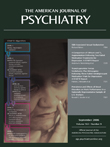To the Editor: The article by David N. Juurlink, M.D., Ph.D., and colleagues
(1) reports that selective serotonin reuptake inhibitors (SSRI) have a 4.8-fold risk of inducing suicide during the first month of therapy relative to non-SSRI antidepressants. In the abstract of the article, it also states that “the absolute risk of suicide with all antidepressants [is] low” (
1, p. 813). The statistical data regarding this “low risk” should have been provided, since without in-depth study of the article, readers may be misled and thus undertreat their patients with depression. In addition, undertreatment may be supported by the Food and Drug Administration (FDA) warning about a possible relationship between antidepressants and suicidality (not suicide). The statistical data reported in the article are 1/3,353 (29/100.000) in SSRI-treated patients versus 1/16,037 (6.2/100.000) in non-SSRI antidepressant-treated patients. The authors state that “many suicides during the first month of treatment likely result from depression,” so that the “actual risk of suicide due to antidepressant therapy is probably far lower” (
1, p. 817). Reporting specific data here would have been much more useful to clinicians than reporting that SSRIs are more risky than non-SSRI antidepressants. Despite the worrying abstract, the statistical data presented suggest that very few patients may become suicidal using antidepressants. Then, there are “speculations” about the “mechanisms” underlying the association between SSRI antidepressants and suicide (p. 818). Among them, there is “treatment-emergent agitation or dysphoria” (p. 818). A recent series of studies has shed some light on the possible mechanisms related to suicidality and antidepressants. Among possible precursors to suicidality, the FDA lists features typical of mixed depression (depressive mixed states), such as irritability, psychomotor agitation, and bipolarity. In mixed depression, defined as a major depressive episode plus three or more intradepression, noneuphoric, DSM-IV hypomanic symptoms, irritability and psychomotor agitation are among the most common hypomanic symptoms, along with racing/crowded thoughts
(2) . The bipolar nature of mixed depression has been validated
(2) . In a large, psychoactive drug-free bipolar II and major depressive disorder sample, it was shown that psychomotor agitation and racing/crowded thoughts are independent predictors of suicidal ideation
(3,
4) . Furthermore, it has been shown that most suicide attempters have a mixed depression before acting
(5) . These findings suggest that there are features of depression that should always be assessed and may make some individuals at risk for antidepressant-induced suicidality, and this is related to the worsening of these intradepression hypomanic symptoms. Therefore, it is not antidepressants that induce suicidality, but the poor use of them. Mood stabilizing agents have been recommended prior to using antidepressants for treating patients with mixed depression
(3,
4) . In addition, systematic probing for intradepression hypomanic symptoms is suggested by the FDA and by findings of these previous studies.

